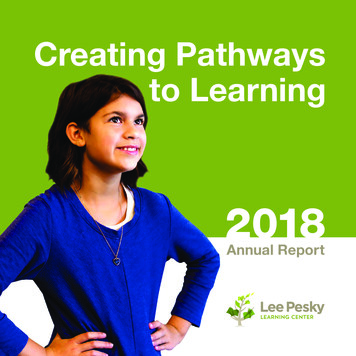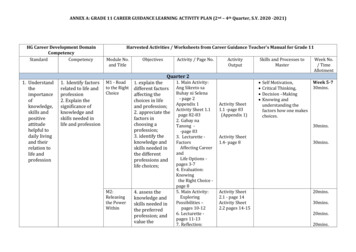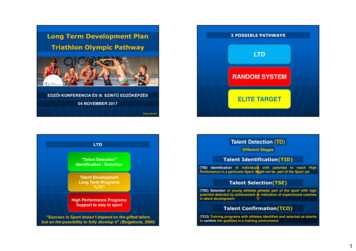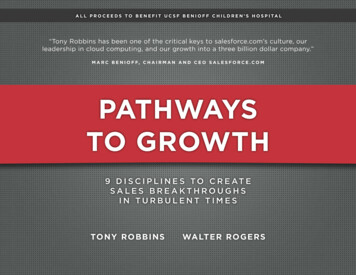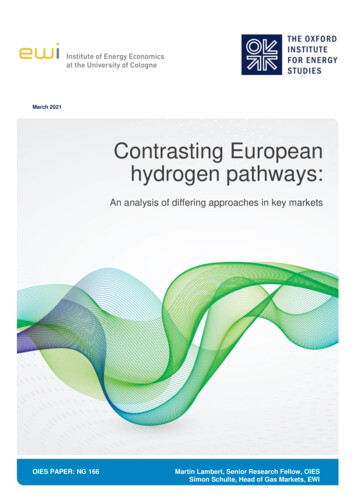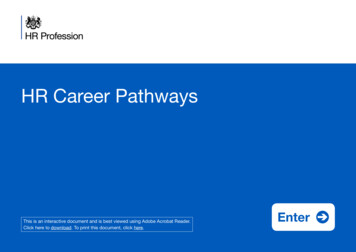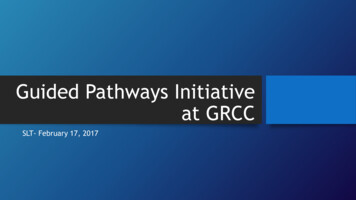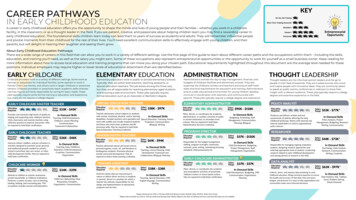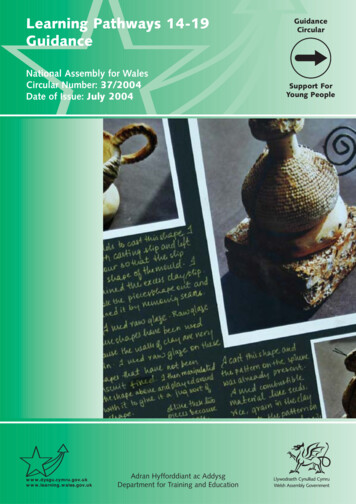
Transcription
Learning Pathways 14-19GuidanceNational Assembly for WalesCircular Number: 37/2004Date of Issue: July 2004Adran Hyfforddiant ac AddysgDepartment for Training and EducationGuidanceCircularSupport ForYoung People
Title of Document:Learning Pathways 14-19GuidanceAudience:Headteachers, curriculum managers and governing bodies ofmaintained schools; local education authorities; diocesanauthorities; 14-19 Networks; further and higher educationinstitutions; teacher and other associations and unions; teachertraining institutions; awarding bodies; training providers;employer bodies; employers; voluntary organisations; and allpartners concerned with 14-19 provision.Overview:This guidance aims to provide details about how LearningPathways 14-19 will work in practice to benefit young people,the economy and communities in Wales. It builds on the ActionPlan 2003 and is part of a series which will continue to build onthe experience and expertise of all concerned.Action requiredThis guidance substantiates the actions agreed in ‘The LearningCountry: Learning Pathways 14-19 Action Plan’. It is the basisfor implementation of Learning Pathways from September 2004.Further information : Enquiries about this guidance should be directed to:Russell DobbinsYouth and Pupil ParticipationWelsh Assembly GovernmentCathays ParkCardiffCF10 3NQTel: 029 2082 5854Fax: 029 2080 1051Email: 14-19@wales.gsi.gov.ukAdditional copies :This guidance is available on the internet atwww.learning.wales.gov.uk and can be copied from there.Alternatively, from September 2004, copies will be available inloose leaf format from Russell Dobbins, using the contactdetails above.Related documents :Wales: A Better Country. 2003The Learning Country: A Paving Document. 2001Learning Country: Learning Pathways.Consultation Document. 2002Learning Country: Learning Pathways 14-19. Action Plan. 2003All full list of related documents and strategies availableat Annex FArtwork on the front cover produced by Natasha Thaladiof Whitchurch High School, Cardiff, as partof her 2004 GCSE Art coursework.ISBN: 0 7504 3420 1Designed by CartoGraphics G/007/04-05JulyINA-15-07-245 Crown copyright 2004Typesetting by Text Processing Services
ContentsContentsArtwork produced by David Knapton, Whitchurch High School, Cardiff as part of his GCSE coursework
ContentsLEARNING PATHWAYS 14-19GUIDANCEContentsPageMinisteral ForewordiiiExecutive SummaryvSectionSection 1: Learning Pathways1.0KEY ELEMENT 1: An Individual Learning Pathway1.1KEY ELEMENT 2: Wider Choice and Flexibility1.2KEY ELEMENT 3: The Learning Core1.3- Work Focused Experience1.4- Community Participation1.5Section 2: Support For Learners2.0KEY ELEMENT 4: Learning Coach Support2.1KEY ELEMENT 5: Access to Personal Support2.2KEY ELEMENT 6: Careers Information, Advice and Guidance2.3Section 3: How The Six Key Elements Will Be Achieved3.014-19 Networks3.1Funding Learning Pathways 14-193.2Section 4: Annexes4.0Annex Amembers of 14-19 groups 2003-044.1Annex Bskills definitions4.2Annex Cplanning grid for balanced Learning Pathways4.3Annex Dpossible job description of a Learning Coach4.4Annex Erole of the 14-19 Networks4.5Annex Frelated documents and strategies4.6Your NotesUPDATED JULY 2004i
iiUPDATED JULY 2004
MINISTERIAL FOREWORDMinisteralForewordThe Welsh Assembly Government affirmed a commitment totransforming 14-19 provision for Wales in our strategic agenda‘Wales: A Better Country’. We recognise how important thisphase is to our main priorities for better health, better jobs,better skills and safer, stronger communities. This work beganwith ‘The Learning Country’ (2001) and continued with‘Learning Country: Learning Pathways 14-19’ (2002). It is nowat the stage where we can issue detailed guidance aboutdelivery.This guidance has been developed through partnership between all thoseengaged in providing for young people in the 14-19 age group, together with youngpeople themselves. As a result we have all the ingredients to help us achieve ourgoal that:"95 per cent of young people by the age of 25 will be ready for high skilledemployment or higher education by 2015"We've been determined from the start that we should build on the good practicethat already exists for some learners in some settings, and make sure that weapply that to an entitlement for all learners wherever they are learning.I've been greatly impressed by the commitment, enthusiasm and creativity of the170 people from all sectors who have contributed to the seven task and finishgroups that have helped shape this guidance. Hundreds of others took advantageof the open way in which it was developed to offer the benefit of theirexperience. That helped to ensure we have a model that will really work for thelearners of Wales. I am very grateful to everyone who contributed to what hasbeen a hugely important process.The partnership approach will continue. The Overarching Steering Group willadvise me on the implementation of, and future guidance for, Learning Pathways14-19. Young people themselves have had the opportunity to make theircontribution throughout. They will continue to do so as part of the OverarchingSteering Group. They will also be valuable members of the local 14-19 Networksset up to implement the local development plans.The transformation of 14-19 provision depends on achieving a balance betweennational and local development. We shall work closely with the 14-19 Networksto ensure that valuable local experience and development is taken account of inthe implementation of national policy.Learning Pathways will transform young people's options and opportunities. Theywill do so by extending choice and flexibility; securing individually tailoredlearning pathways that meet learners’ needs, and providing richer opportunitiesand experiences which will help learners develop the wider skills they need forlife and work. They will take full account of evidence from ‘Future Skills Wales’about what learners need for employability, as well as what they need to livefulfilling and successful lives.UPDATED JULY 2004iii
MinisterialForewordThe unique blend of support to be put into place will ensure that all learnershave the advice and guidance they need to make good choices and to overcomebarriers to learning. It will enable them to appreciate that their physical, social andemotional health is as essential to realising their potential as their intellectualdevelopment.This guidance will help put into place Learning Pathways for all learners. We shallcontinue to build on experience gained from the pilot programmes, from theexperiences of 14-19 Networks, from learning settings and from learners.However, this guidance represents a major step forward. Over time, it will ensurethat a very much wider range of options is available for learners across the board.It puts a progressive transformation of learning opportunities at 14-19 well withinour grasp. It represents another substantial step towards making Wales a ‘LearningCountry’.Jane Davidson AMMinister for Education and Lifelong LearningivUPDATED JULY 2004
EXECUTIVE SUMMARYExecutiveSummaryWhat is to be achievedThe Welsh Assembly Government is committed to transforming 14-19 provision inWales. We want:'95 per cent of young people by the age of 25 to be ready for high skilledemployment or higher education by 2015'Learning Pathways consist of a blend of six key elements which, in combination,will ensure that, over time, all learners receive the appropriate balance of learningexperiences that best meet their needs. The key elements also enable learners toreceive the support and guidance they need to realise their potential. The six keyelements are: individual Learning Pathways to meet the needs of each learner; wider choice and flexibility of programmes and ways of learning; a Learning Core which runs from 14 through to 19 wherever young people arelearning; Learning Coach support; access to personal support; and impartial careers advice and guidance.Learning Pathways 14-19 will encourage more young people to achieve theirpotential so they are increasingly better equipped for the world of work and tobecome better informed and more active citizens. It will do this by contributingto an improvement in qualifications, supporting an improvement in theproportion of 16 year olds progressing to further learning in education andtraining, widening choice, promoting equality of opportunity and supporting theachievement of ‘Extending Entitlement’.How it will be achievedLearning Pathways: Key Elements 1, 2 and 3 There will be a progressive roll out of entitlement to Learning Pathways, thepace to be confirmed following consultation with the Overarching SteeringGroup. This will take account of available funding and capacity analysis, and14-19 Network development plans. Enhanced choice and flexibility will be available in option menus fromSeptember 2004 onwards supported initially by a Welsh AssemblyGovernment grant of 50,000 to each 14-19 Network. There will be greater opportunities for community participation and workfocused experience within a Learning Core as set out in further guidance fromSeptember 2005, with capacity building activities work, supported by theWelsh Assembly Government, from September 2004.UPDATED JULY 2004v
ExecutiveSummarySupport For Learners: Key Elements 4, 5 and 6 Personal support and Learning Coach support will be introduced in targetedareas from September 2004 as part of a pilot programme; good practice inthese aspects outside the targeted pilots will also be gathered to informadditional guidance in summer 2005. Careers information, advice and guidance will be part of the package ofsupport for learners. There will be a progressive roll out of entitlement to Education MaintenanceAllowances for 16-18 year olds from September 2004.Making it work: 14-19 Networks 14-19 Networks, working with the local Community Consortium for Educationand Training (CCET) and Young People’s Partnership (YPP) in each localauthority area, will identify the priorities for their area and produce their firstdevelopment plan for implementation from September 2004, includingproposals for taking forward Learning Pathways.These developments will also reflect lessons to be learnt from the WelshBaccalaureate Qualification (WBQ) pilots, the development of the Credit andQualifications Framework for Wales (CQFW), the review of the Key Stage 4 (KS4)national curriculum requirements, ‘Extending Entitlement’, and arrangements forthe education and training of young offenders.viUPDATED JULY 2004
Section 1Learning PathwaysLearning PathwaysArtwork produced by David Knapton, Whitchurch High School, Cardiff as part of his GCSE coursework
SECTION 1: LEARNING PATHWAYSKEY ELEMENTS 1, 2 AND 3: Individual Learning Pathways, WiderChoice, Flexibility and the Learning CoreThis section setsout the elementsof provision thatare essential todeliveringLearning PathwaysWhat Learning Pathways are:In generic terms Learning Pathways are the learning experiences of eachindividual 14-19 year old. They involve developing an entitlement for eachlearner. They include a balance of formal learning, wider choice, flexibility and aLearning Core 14-19, together with a unique blend of support to meet learners’needs.The 6 key elements of Learning Pathways are:Learning Pathway1INDIVIDUALLEARNINGPATHWAY23WIDER CHOICEANDFLEXIBILITYTHELEARNINGCOREIndividually tailored Learning Pathway (which recognisesstatutory requirements) leading to approved qualificationsand awards of credit, appropriate learning at the rightlevel(s) at the right time for the learner to meet needs,aptitudes and interests and running from 14-19 and beyondWider choice of relevant options from a range ofdomains1, and greater flexibility to vary speed anddirection of pathwayWider learning consisting of the skills, knowledge,understanding, values and experiences that all 14-19 yearolds will need, whatever their Learning PathwaySupport for Learners2456LEARNINGCOACHEntitlement to learning support: opportunity to discusslearning and progress on a regular basisPERSONALSUPPORTAccess to personal support when needed: self-referral orby agreement with learner, referral by someone elseCAREERSADVICE ANDGUIDANCEImpartial careers advice and guidance to inform theindividual’s Learning Pathway1: See section 1.22: On occasions aspects of learning support, personal support and careers advice and guidance may beprovided by the same personUPDATED JULY 2004SECTION 1.0
This section setsout the elementsof provision thatare essential todeliveringLearning PathwaysWhat we want to achieve1.Learning Pathways 14-19 will: lift the proportion of 16 year olds with level 2 and the proportion with level 3qualifications at 19; reduce the number of young people leaving full time education with noqualifications; improve the proportion of 16 year olds progressing to further learning, fulltime or work-based; reduce the number of 16-18 year olds not in education, employment ortraining (NEET); increase attendance, reduce exclusion and improve retention; enable more young people to realise their potential; provide a positive focus on achievement where young people’s success iscelebrated; support young people’s capacity to be more independent, make choices andparticipate in the democratic process; and impact positively on basic skills, workforce skills and sustainable employment.2.Learning Pathways 14-19 will also contribute to enhancing employmentopportunities; to supporting the development of equal opportunities; toincreasing real Gross Domestic Product (GDP); to reducing poverty, including inCommunity First areas; to reducing anti-social behaviour and criminal activity; andsupporting improved health.3.to:SECTION 1.0Learning Pathways 14-19 will contribute to the aims of ‘Iaith Pawb’ by seeking offer provision in the language of choice wherever possible; place an emphasis on developing young people’s bilingual skills; and equip young people with skills in Welsh and English which will enable them tolearn and work within a bilingual society.UPDATED JULY 2004
Key Element 1: An Individual Learning PathwayWhat an individual Learning Pathway is:A Learning Pathway is the learning experience of each individual 14-19 year old. Itconsists of a Learning Core and the choice of options from which the learnerselects, with informed support and guidance.This sectiondefines theframework whichmakes up anindividuallytailored LearningPathway1.Learners will select, with support and guidance, options which suit theirinterests, abilities and learning styles, and which will provide opportunities tohelp them realise their potential.2.A Learning Pathway should: promote inclusion by providing opportunities for all learners to have access toa broad and balanced range of experiences. This will enable all learners todevelop the skills they need for life and work to take into account theevidence from the ‘Future Skills Wales Survey’ (2003); recognise experiences from all aspects of a learner’s life including part timeemployment and participation in activities outside the formal learningenvironment, for example, caring responsibilities; and recognise the support, which will vary over time, that learners need to helpovercome barriers to learning and the means for each learner to access aunique blend of support to meet their individual needs.UPDATED JULY 2004SECTION 1.1
SECTION 1.1UPDATED JULY 2004Option MenuWork focused experienceCommunity participationThe Learning Core: wider learning consisting of the skills, knowledge,understanding, values and experiences that all 14-19 year olds will need,whatever their Learning Pathway14-19 NetworksCareers Wales14-19 NetworksLearning Coach supportfor all learners, thoughnot necessarily onindividual basisPersonal support networkswith backup from specialistservicesAccess to personal support when needed: self-referral or by agreement withlearner, referral by someone elseImpartial careers advice and guidance to inform the individual’s Learning Pathway Careers Wales working with14-19 NetworksLearning Coach14-19 Networks14-19 NetworksEntitlement to professional learning support: opportunity to discuss learningand progress on regular basis1: See section 1.2SUPPORTOption MenuWider choice of relevant options from a range of domains1, and greaterflexibility to vary speed and direction of pathwayLearning settings14-19 NetworksThis sectiondefines theframework whichmakes up anindividuallytailored LearningPathway9:37 amActivities/experienceswithin and outside leadlearning settingIndividual learningsetting/14-19NetworkIndividually tailored Learning Pathway (which recognises statutoryrequirements) leading to approved qualifications and awards of credit,appropriate learning at the right level(s) at the right time for the learnerto meet needs, aptitudes and interests and running from 14-19 and beyondWho21/9/04PATHWAYDeliveryEssential elementHow Learning Pathways Will Be Delivered: Six Elements To Transform 14-19 Learning In Wales28055 english A4 PAGESPage x
3.Each learner’s Learning Pathway will have a combination of formal, nonformal and informal elements. The balance between the elements will varyaccording to the learner’s needs.FORMAL – organized learning opportunities leading to approved qualificationsand/or CQFW credit achievements.This sectiondefines theframework whichmakes up anindividuallytailored LearningPathwayNON FORMAL - organized programmes that may lead to accreditation buttypically outside the National Qualifications Framework (NQF).INFORMAL - wider experiences normally without formal recognition.4.The illustrative grid overleaf shows some of the experiences which mightconstitute a balance between formal, non-formal and informal in an individual’sLearning Pathway. It does not preclude the opportunity for an individual to, forexample, continue some General Certificates of Education (GCSE) post 16, or startan A-level before year 12.Further guidance on what constitutes an individual Learning Pathway will beissued early in 2005.UPDATED JULY 2004SECTION 1.1
SECTION 1.1NON-FORMALOrganised programmesleading to accreditationbut normally outsidethe NQF; can includecredit accreditionOrganised learningopportunitiesleading toapprovedqualificationsUPDATED JULY 2004 Year 13Statutory requirementsin schoolYear 12Work based learning leading to approvedqualificationsDuke of Edinburgh’s Award bronze/silver/goldASDAN and similar awardsMIllennium Volunteers/CSVFirst Aid/Food Hygiene certificates etcOCN levels 1/2/3Other aspects of the Learning CoreResidential experiencesHobbies/sport activitiesMembership of clubs/societiesPart time employment (recognising legalrequirementsBabysitting/caring skillsApproved qualifications from list in appliedand general formsGCSEs/NVQs/GNVQs/BTEC etcAS/A levels/WBQ CoreSome specific requirements of theLearning CoreNational Curriculum/StatutoryRequirementsYear 11FORMALYear 10Year 9LEARNINGPATHWAYAn Illustrative Planning Grid For Balanced Learning PathwaysAssessment/Learning styles identified; range of taster activitiesBeyondYear 13A blank full-page grid is producedat Annex C.Learning Coach support will helpthe individual to identify goalsand develop a Learning Pathway.This example grid is not allinclusive by either range oflearning or age.Individual Learning Pathways willvary and should provideappropriate formal, non-formaland informal learning at the rightlevels at the right time for thelearner to meet needs, aptitudesand interests.This sectiondefines theframework whichmakes up anindividuallytailored LearningPathwayContinuation of learning toward credit achievement, qualifications orpersonal goals. Negotiated extension of time to complete qualifications.Lifelong Learning including in Further and Higher education
Key Element 2: Wider Choice and FlexibilityWhat wider choice and flexibility means:All learners at age 14-19 should be able, with support, to design their LearningPathway from a sufficiently wide range of options leading to a range ofqualifications. They should also have access to opportunities in applied orgeneral forms to recognise their learning styles and enable them to experiencesuccess.This sectiondescribes theframework forproviding choiceand flexibilitywhich will enablelearners to designtheir LearningPathwaySecuring extended provision for choice and flexibility1.The 14-19 Network should work to ensure co-operation between partnersto secure a broad and balanced range of opportunities, recognising statutoryrequirements, from which learners can develop their own broad and balancedindividual Learning Pathway. An audit of current provision may show that in manyareas a wide choice already exists. In order to ensure a basic level of choice andflexibility across Wales, provision should be analysed and developed within thefollowing framework.2.OPTION MENUS contain the range of choices made available through theco-operation of partners in the 14-19 Network from which young people canchoose formal aspects of their pathway. A Prospectus of Activities should bedeveloped to cover the range of non-formal and informal opportunitiesavailable within an area.3.For the formal aspects the framework below will ensure that learners haveaccess to appropriate breadth, balance and relevance with flexibility to meet theirindividual needs. Provision in the 14-19 Network area should include programmesat each level, from entry to level 4, in applied and general forms, to recognisedifferent learning styles in the DOMAINS shown in the diagram overleaf.4.Domains are intended as a means of securing the necessary range ofprovision. They do not indicate or demand any specialism or provide a frameworkfor learner choice in themselves. They seek to underpin a minimum level ofprovision. They recognise that practicality, logistics and economies of scale willinfluence the eventual range of provision possible. Cross border collaboration,underpinned by technological developments such as the Broadband LifelongLearning Network, will extend the range of choice where appropriate in someareas and for some learners.UPDATED JULY 2004SECTION 1.2
This sectiondescribes theframework forproviding choiceand flexibilitywhich will enablelearners to designtheir LearningPathwayIllustrative Domains Framework for 14-19 Options Provision Mathematics, science and all aspects of technology Business and management Services to people Creative arts and culture Humanities and languages5.Within each domain there will need to be a range of options in generaland applied forms, from entry level to level 4. Most learning settings alreadyoffer some provision in each domain. The 14-19 Network should, over time, seekto expand the range of options at each level in each domain. There will be aparticular need to consider how to increase provision within each domainthrough the medium of Welsh.What the learner will gain through designing their Learning Pathway6.Learning Coaches (see section 2.1) will work with individual learners on aone-to-one basis or in small groups, to establish goals and to develop aLearning Pathway for each learner that will include formal, non-formal andinformal opportunities phased over time. It will take into account experiencesoutside the learning setting, and which help in realising individual ambitions.7.Learners will need to have access to the widest possible choice but willneed to understand that for some goals there will be specific pre-requisites foraccess, for example Mathematics and English GCSE A*-C for teaching. Supportfrom the Learning Coach and Careers Adviser will help develop thisunderstanding.8.Learners aged 14-16 will have Learning Pathways that include programmesfrom several domains through the statutory national curriculum requirements atKey Stage 4 in Wales 2004: For all learners 14-16 in any learning setting(unless formally disapplied)National Curriculum Mandatory Subjects: English, Welsh (as a first or secondlanguage), Mathematics, Science, Physical EducationOther statutory requirements: Religious Education, Sex Education, CareersEducation and Guidance, Personal and Social Education, Work RelatedEducation (from September 2004)16-19 statutory requirementsMaintained schools: Religious Education, Sex Education, Careers Education andGuidanceFurther Education: Careers Education and GuidanceSECTION 1.2UPDATED JULY 2004
Key Stage 4 (KS4). Future developments in the statutory requirements will reflectthe nature of developments in Learning Pathways themselves.9.Learners aged 14-16 should be provided with appropriate breadth andbalance and should be encouraged to keep their options open. There is sufficientflexibility in the statutory requirements to allow those who wish to begin tospecialise in one or more domains. Learners post 16 will be more likely to refinetheir goals and consequently their Learning Pathway towards a more specific setof options.This sectiondescribes theframework forproviding choiceand flexibilitywhich will enablelearners to designtheir LearningPathway10. Learning Coach support will need to provide impartial and practicaladvice and guidance on pathways which best meet both the individual learner’sneeds and reflect the learning styles which suit them best.Further guidance on Learning Pathways will be issued early in 2005UPDATED JULY 2004SECTION 1.2
SECTION 1.2UPDATED JULY 2004
Key Element 3: The Learning CoreWhat the Learning Core 14-19 is:The Learning Core is the proposed wider learning for all young people in Walesfrom the age of 14 to 19. It is made up of minimum requirements plusenhancements. As a minimum, it consists of the skills, knowledge, understanding, attitudes,values and experiences that all learners need to prepare them for furtherlearning, employment, personal fulfilment and their contribution to ourbilingual and diverse society, regardless of the Learning Pathway that alearner chooses to follow. Learners should also have access to enhancements to the minimumrequirements to develop their core learning for their chosen pathway and/orto fulfil an interest that will enrich their lives.This sectiondescribes whatthe Learning Coreat 14-19 is andwhy this learningis important forall 14-19 year olds.It also gives someguidance onmoving towardsimplementation infull for all learnersThe detailed model for the Learning Core as set out in thissection has been designed to:1. motivate learners whatever their pathways; be flexible enough to apply to all; accommodate a wide range of learning styles and the full range ofintelligences; and be manageable in terms of volume.2.The minimum requirements are intended for full time learners based inthe workplace, those on mixed Learning Pathways, including work-based learningand other learning settings and those in full time study in schools and colleges.The minimum requirements, as part of the whole Learning Core, will supportwider learning in all these contexts.3.The enhancements make the model flexible enough for all learners.Learners should further develop their core learning for their chosen pathwayand/or to fulfil interests that enrich their lives. This flexibility is designed to bemotivating for individual learners as well as practicable for providers,especially in work-based routes.4.The volume has to be manageable and avoid overload, particularly in termsof learning time, content and assessment. The Learning Core must reflectstatutory requirements (see section 1.2) rather than adding to them. TheQualification, Curriculum and Assessment Authority for Wales’ (ACCAC) advice onthe review of the KS4 curriculum assessment and qualifications is designed toensure consistency between the KS4 requirements and the Learning Core.5.The Learning Core contains those aspects of wider learning which can beconsistently applied for learners aged 14-19 in all settings. It does not, therefore,UPDATED JULY 2004SECTION 1.3
This sectiondescribes whatthe Learning Coreat 14-19 is andwhy this learningis important forall 14-19 year olds.It also gives someguidance onmoving towardsimplementation infull for all learnersSECTION 1.3include important statutory requirements which apply only in schools, such asReligious Education (RE) and science as a national curriculum subject at KS4. Theyremain essential elements of the school curriculum.6.The level of the learning is not defined in the model. Programmes forlearners should be designed to encourage individuals to achieve the highest levelof which they are capable. It does not specify particular learning programmes orassessment requirements since these may vary between learning settings. Themodel gives flexibility for learning providers, working within their local 14-19Networks, to decide on the nature of the specific learning programmes andassessment arrangements that they wish to put in place to meet their learners’needs.UPDATED JULY 2004
Moving towards full implementation of the Learning CoreImplementing the Core7.The full implementation of the Learning Core for all 14-19 year olds will taketime and preparation. The model has explicitly taken account of other majordevelopments in curriculum and qualifications including the school curriculum 1416, the WBQ and Modern Apprenticeships (MAs). There is a need for furtherdevelopments in these areas to maximise consistency with the Learning Core.However, in the immediate future, 14-19 Networks and learning providers canmake considerable progress to implement as much of the Learning Core as theyfind manageable under present arrangements.This sectiondescribes whatthe Learning Coreat 14-19 is andwhy this learningis important forall 14-19 year olds.It also gives someguidance onmoving towardsimplementation infull for all learners8.Much of the Learning Core may already be an integral part of learners’existing programmes. Learning providers should build on what is already in placeand identify what additional provision is needed to de
Annex C planning grid for balanced Learning Pathways 4.3 Annex D possible job description of a Learning Coach 4.4 Annex E role of the 14-19 Networks 4.5 Annex F related documents a
